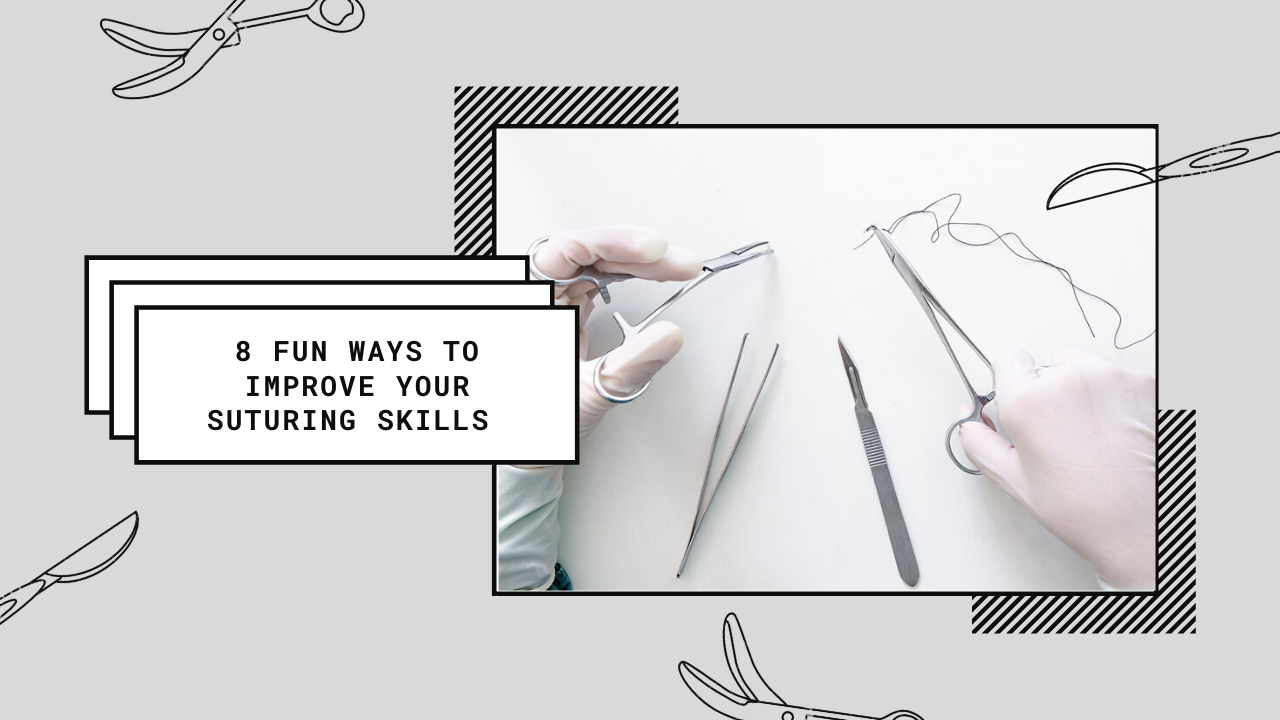
14 Aug 8 fun ways to improve your suturing skills
One of the most attractive aspects of medicine as a career is an intellectually stimulating and hands-on work environment. I don’t know about you, but I’m a pretty hands on person. Whatever branch of medicine you wish to pursue you have to suture, and if you want to be as good at suturing as you are at showing empathy over teams in comm skills, you’ve come to the right place.
- Get a hand gripper.
Even basic suturing requires closing and opening of the needle holders between your thumb and ring finger. Needle holders can be really stiff and I’ve definitely let out strings of curses trying to get mine closed. Increasing your general hand strength will also improve endurance, and make fine dexterity tasks easier.
Where to find a hand gripper: I saw them at Daiso recently, or order online; this is a pretty fancy one https://www.bigw.com.au/product/circuit-hand-gripper/p/634125/.
- Try out rock-climbing or bouldering.
Similar sort of reasoning to above. Improve that forearm/grip strength. If you’ve ever seen a rock-climbing wall, you’ll probably remember those teeny tiny pinch holds that make you go excuse me what?? Well, with enough practise you’ll gain some sick pinch strength from rock climbing, and it’s a good work out too.
Where to find a rock-climbing place: https://www.theurbanlist.com/goldcoast/a-list/best-rock-climbing-gold-coast.
- Craft projects.
Knitting, crotchet, sewing, quilting, jewellery making. Little did you know, while we’re listening to Louise and Christian making shameless innuendos over collaborate, I’m often crocheting. Craft projects are intensely satisfying and meditative, but also an awesome way to improve fine dexterity.
Where to find craft projects: you should be able to find plenty of places on the internet but https://www.youtube.com/ is a good place to start.
- Origami
When my desk began to get out of hand approx. 2 months into COVID I cleared it off and found about 20 discarded paper cranes; I don’t know how to origami anything else. Origami is one of the things they get seniors to do at homes to keep dexterity and mental acuity. So, maybe this particular task should be saved for all those elderly non-medsci folk.
Where to find origami paper: Daiso again coming in hot as your number one destination, or use your DHC notes.
- Learn a musical instrument.
Kind of a big investment I know. But why don’t you get your hands on an el cheapo ukulele, and learn how to play a classic four chord banger (I’m looking at you, every pop song ever). Not only will you have a fun party trick but you’ll have improved both dexterity and finger strength.
Where to buy a ukulele: https://aandbmusic.com.au/collections/ukes/products/mahalo-mr1-soprano-ukulele-pick-a-colour, free shipping! And pick any colour you want!! If you get a boring colour I’m never talking to you again!!!
- Do a puzzle
*Finger snap* puzzle time! There are some seriously awesome cognitive benefits from doing puzzles, go on and google it if you’re interested. While you’re training that big future doctor brain of yours you also get some fine motor skills in, along with the ability to better regulate your emotions when you can’t find the piece you’re looking for.
Where to find a puzzle: your local board game store, or the back of your Nana’s closet covered in cobwebs.
- Paint your nails.
Every person who has painted their nails knows the absolute tragedy of your non dominant hand looking hot, then your dominant hand looking like your 5-year-old cousin got loose on it. Easily rectified. Paint them heaps, improve your non-dominant hand dexterity, show off your sexy nails (masculine folk, you too, break down those gender norms).
Where to buy nail polish: legit pretty much anywhere, but maybe give the dollar shop polish a miss for the health of your pretty dextrous fingers.
- Sleep!
Saved the best for last as sleeping is the funnest thing to do of all. A 1998 study of trainee surgeons found that the ability to perform dexterous tasks is impacted depending on the amount of sleep the trainees had had (1). Errors, time to complete the task, and stress all increased in a kind of freaky linear fashion with decreasing amount of sleep.
Where to find sleep: philosophical question that unfortunately I cannot answer for you in the scope of this blog post.
So, now that you’ve read this article, take a break from study and practice some of the fun, high yield activities listed above. I hope to see you all back at G40 with your buff forearms, sick fine motor skills and sexy fingernails soon.
References:
1 – Taffinder, N. J. McManus I.C. Gul, Y. Russell, R.C. Darzi, A. (1998). Effect of sleep deprivation on surgeons’ dexterity on laparoscopy simulator. The Lancet; 352 (9135): 1191.
Thanks to Vinny Abeygunawardana for designing the banner.

